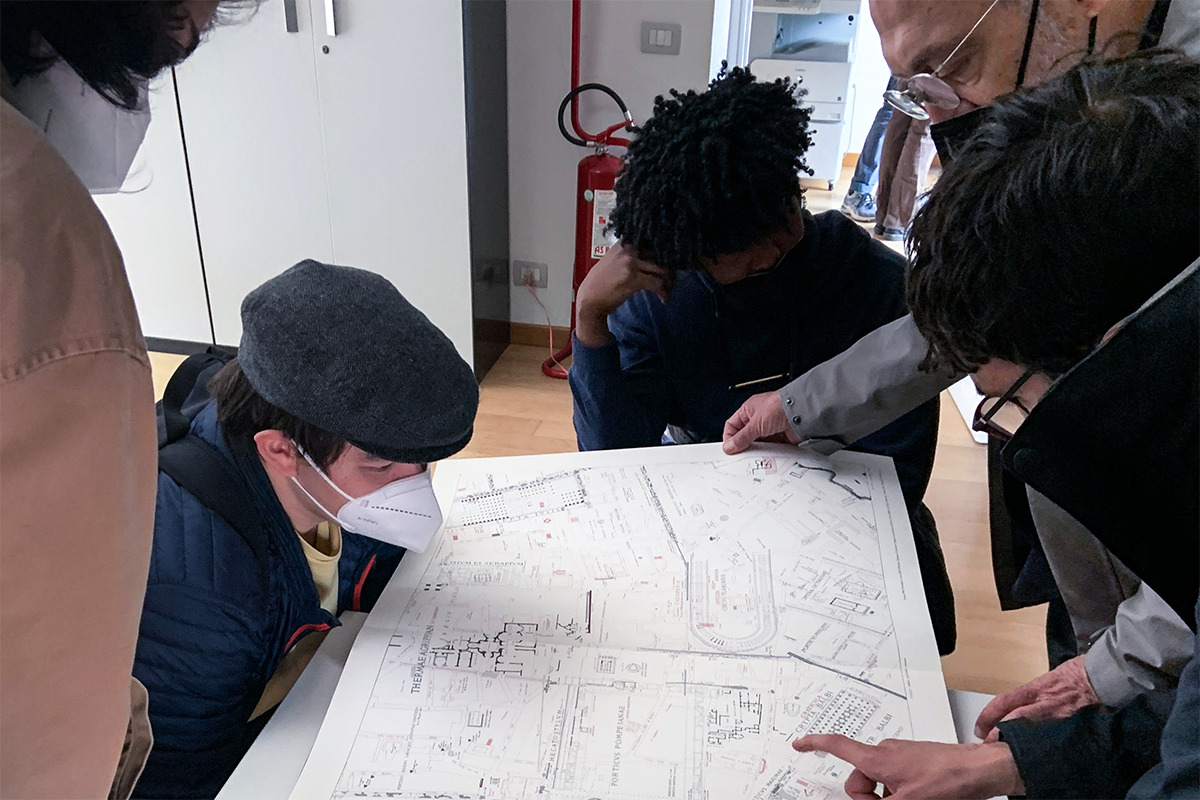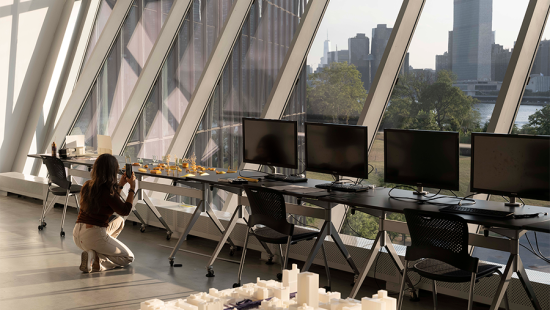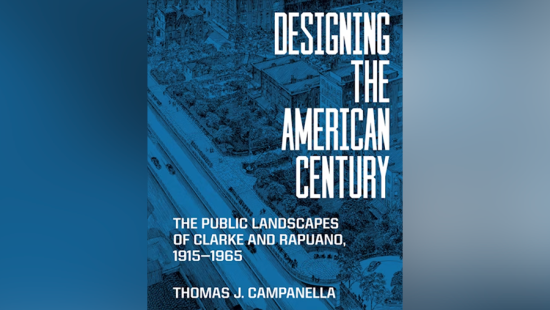Intersections: Jeffrey Chusid on Exchange, Evolution, and Conflict in Planning
From Cornell in Rome, Associate Professor of City and Regional Planning Jeffrey Chusid shares thoughts on his work as a preservation planner and critical concerns for the discipline today.

Jeffrey M. Chusid is an architect, planner, and associate professor, and he recently completed his appointment as Chair of the Department of City and Regional Planning. Chusid has had a decades-long career as a preservation architect and planner with a particular focus on modernism, sustainable development, and the fate of historical resources in areas of cultural exchange and conflict. In addition, he has consulted on preservation, planning, and economic development for historic sites, museums, and cities internationally and across the U.S.
Currently, Chusid is coteaching at Cornell in Rome's planning workshop, helping students with survey and community engagement methods and deepening their capacity to work across cultural and disciplinary differences as they venture out to select neighborhoods, often encountering sites where ancient history meets new development.
Chusid's work encompasses design and preservation projects, articles, and books. He is currently writing a new book on the life and career of architect Joseph Allen Stein and working with the Cornell library to catalog and preserve Stein's archive, which was recently donated by his family.
An avid proponent of finding generative intersections between knowledge of urban and architectural history and contemporary issues ranging from immigration to preservation in planning, Chusid offers thoughts on his work and critical concerns for the discipline today.
1
You are a planner, architect, and preservationist interested in cultural exchange, shifting historical narratives, and contested territories. Essentially, you look at far more than the built environment itself, instead focusing on the human aspects of a site. How do exchanges, evolution, and conflict make a case for preservation or offer up new practices in urban design and development? How, or where, does this apply to Rome today?
The complex cultural debate around what makes a site important and worth saving is one of the most interesting parts of my work. Perhaps the most fundamental argument I make as a preservationist for saving a site is that it exists outside of and beyond disciplines or attempts to represent it in words or images. These forms of representation only deal with limited aspects of a site's total reality and often fail to capture its significance to people and their lived experience over time, its aesthetics, cultural meanings, functions, and the various technologies used in its construction, as well as its place in the broader world. I value bringing tools, methods, and theories from multiple disciplines and perspectives to thinking about place and I believe that looking at a site through only one disciplinary lens fails to capture what others, whether subtle or critically significant, might find most valuable.
If we think about a building in the historic center of Rome today, it has played, and continues to play, so many roles: part of the urban fabric, home to multiple families across generations, an economic engine for its owners and others who serve its inhabitants and visitors, a physical record of aesthetic movements and cultural aspirations, a product of the hands of dozens if not hundreds of artisans, builders, designers — often not only during its initial construction but many times since, and a resource for future generations. But there are other issues that can impact the site and its residents around the conflict between tourism and the quality and affordability of living in the core; between the rising tide of homelessness and, paradoxically, increasing vacancies; around sustainability; and the political difficulties of governing the city.
Planners understand that the range of stakeholders, issues, and interests in virtually any project with which they are involved requires multiple techniques to elicit relevant information and to engage disparate audiences in finding appropriate ways to move forward. And we need to know about a wide range of similar projects implemented in other places and situations. As a planner and historian, I am interested in cities and sites — and the people who make and inhabit them. But even with that focus on physical planning, there is a need for empathy, interpersonal skills, and deeply felt ethical positions. The great value of Rome for our students is that the city and the experience of being here makes all this clear and personal in an intense and, often, joyous way.
2
You have described Rome as a major European cultural hub where the Global North meets the Global South — historically, but in particular, in the present day. How does the city and its communities reflect the current issue and ever-open question of immigration?
Rome has approximately 350,000 migrants, the largest of any city in Italy, which itself has the third-largest number of immigrants in Europe after the U.K. and Germany. Italy has long been a crossroads of cultures, home to settlers from around the Mediterranean and the rest of Europe, including Arabs, Celts, and Greeks, and in more recent centuries, Spanish, French, and Austrian rulers — all in addition to the diverse peoples that have lived in the peninsula since prehistoric times.
Walking the streets of Rome, our students encounter 16th-century palazzi owned by the same princely families for multiple generations and buildings occupied by squatters who have established sophisticated extra-legal social networks and services; they see mini-marts, here called Bengals, as a nod to the Bangladeshi immigrants who appear to own and run the majority of them in the city; they see buildings sporting graffiti by neighborhood kids and by Banksy — tags, expressions of contempt for rival soccer teams, surrealist artworks, political statements — a whole other international language for visitors and residents alike. They see the stratigraphy of 2,000-plus years of history in the material fabric of the walls, in the curves of streets, in the many interpretive plaques, the columns and arches and fountains that seem to sprout around every corner, and even in the brass "stolpersteine" under feet commemorating the residents of Rome taken away by the Nazis and their fascist collaborators. All of this forms a context that is global because of current events, and because Rome has been a global city for millennia.
3
There are 21 districts in the city of Rome. The workshop you are coleading at Cornell in Rome focuses on two neighborhoods, Esquilino and Statuario. Why these? What methods do students utilize to pick up and pursue a line of inquiry and what are you finding to be the outcome of the questions they ask?
I selected a theme this year (narratives) broad enough that the students could identify specific planning issues that they felt were important, and to keep my own areas of expertise — design and preservation — under check. After all, those topics are evident everywhere you turn in Rome. In addition, I hoped the students would see preservation as about the living city and its future, not merely the conservation of past monuments or even about the multitudes of tourists.
Hence, our point of entry across both neighborhoods this semester has been the concept of narrative — storytelling by the residents that helps them, and us, construct an understanding of the places where they live, and of the planning problems and opportunities they face. Our syllabus states: "We act for a variety of reasons, from intellectual interest to financial need to moral compulsion. To do so we interpret the phenomena of the city in ways that make sense to us and justify our actions. This process of interpretation is central to planning, as it is to many if not most disciplines. In interpreting a thing or a place we construct a narrative, a story that explains that thing or place’s history, its significance and, often, its need for us to intervene."
While students start their studies by walking the neighborhoods, drawing, photographing, and note-taking, they soon begin to engage locals in conversation, even having some join them in drawing Lynch maps (mental maps of their communities) and discussing planning concerns. That is when the narratives the inhabitants create begin to surface. This year, the two neighborhoods we picked for the planning workshop were Esquilino, inside Rome's Aurelian Wall, and Statuario, in the southeast of the city. The neighborhoods are connected by an ancient aqueduct, the Claudia, but otherwise very different. Together, however, they help encapsulate the breadth of lived experience in a city that is both ancient and contemporary.
4
Turning back to your own research: This summer, you return to Ithaca for sabbatical to continue a decade-long project of writing a book about the life and work of architect Joseph Allen Stein. As part of your historical research, you were able to secure a gift of a substantial collection of his documents for the Cornell Library. Why Stein?
I chose to work on Joe Stein for several reasons. First, his biography was something I could relate to: a Jewish architect who spent formative years in the San Francisco Bay area (where I was born), and who had friendships with many of the architects with whom I studied at UC Berkeley. Second, his Bay Area and Frank Lloyd Wright-inflected modernist style resonated with the work I had done previously studying Wright in Los Angeles and the modern movement in California in the 1910s through 1960s. Third, his career starting in the U.S. but involving almost 50 years working in India gave me carte blanche to move my attention (and at times, my body) to another part of the world and explore a range of topics with which I have always been fascinated: the expatriate as outsider and ultimate insider, modernism as it swept across the globe through colonialism, and the impact of the Blacklist and the post-World War II anti-communist scare in the U.S. on architects and artists. Stein, having been essentially forced out of the U.S. and within a few short years building the largest architecture and engineering firm in India was a great case study of all these issues.
I had the pleasure of meeting Joe years ago at the home of a colleague of mine at USC, Achva Stein, who was his daughter-in-law. My ongoing friendship with Achva and David Stein, Joe’s older son, has greatly facilitated my access to Joe’s story, as has my subsequent friendship with Joe’s younger son, Ethan. The family’s commitment to telling Joe’s story and celebrating his legacy of important buildings, writings, and visionary designs has provided me with invaluable support and led to their decision to give his surviving archives to the Cornell library.
5
And just for fun — if you could choose your favorite place in Rome, where would it be?
Wherever I happen to be when you ask the question. But it will likely be a place with artichokes for sale or on the menu.
Stay connected! Follow @cornellaap on Instagram, Facebook, Twitter, and LinkedIn; and subscribe to our AAP bi-weekly newsletter.







